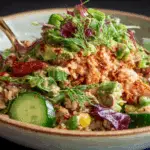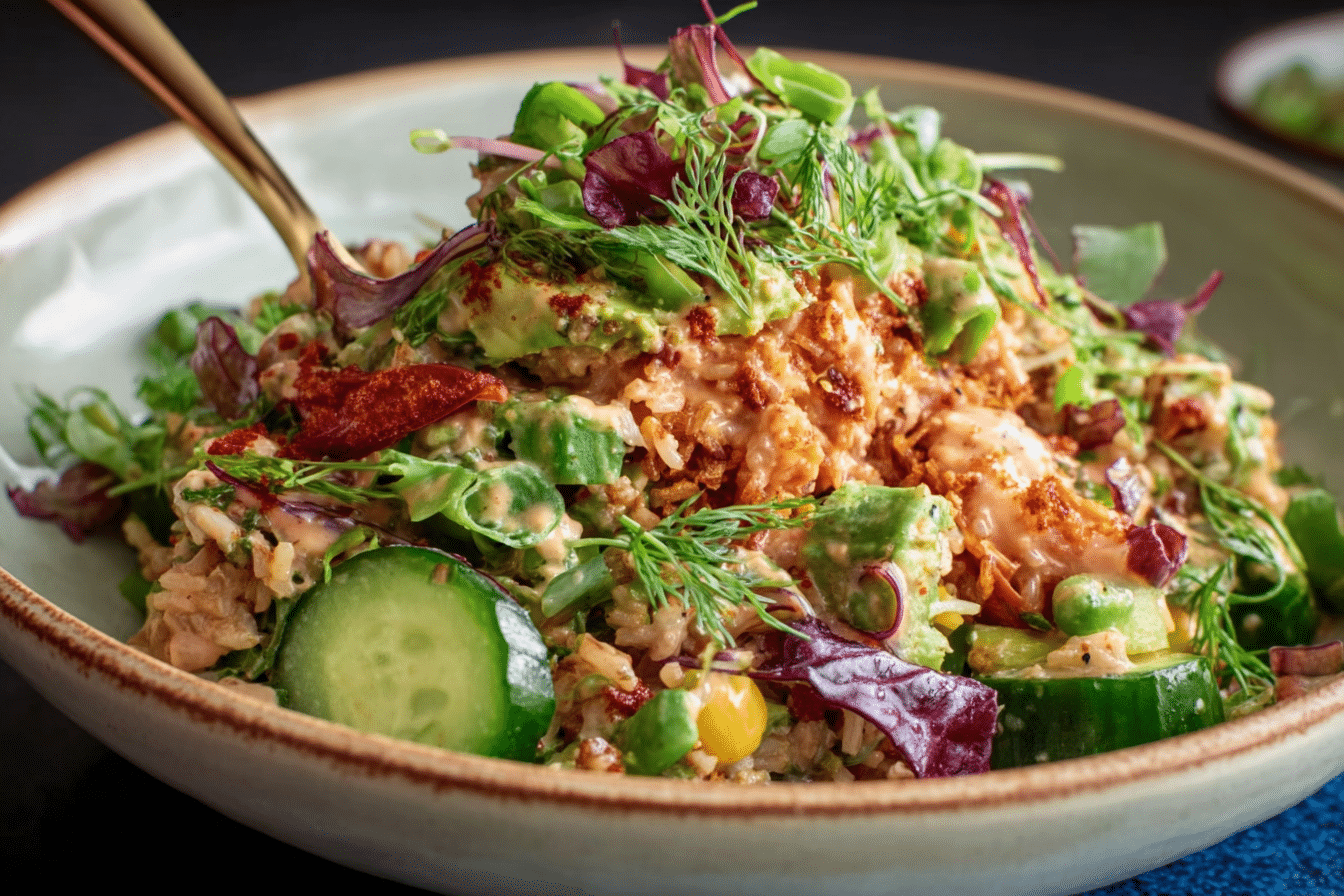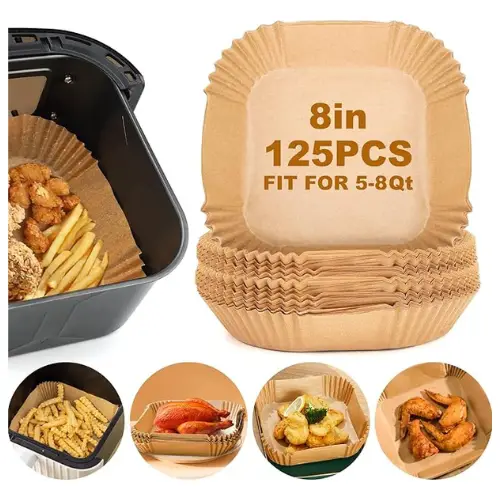There’s something simply magical about a crispy gochujang rice salad. The perfect balance of crunch, spice, freshness, and creaminess brings a bold twist to a classic grain bowl. Here at CookTune, we believe healthy eating should never be boring. That’s why today we’re diving deep into this zesty, savory, and addictive salad that’s as stunning to serve as it is to taste.
Disclosure: This post contains affiliate links.If you click and make a purchase, I may earn a small commission at no extra cost to you.
This Crispy Gochujang Rice Salad was born from our obsession with fusion dishes that blend bold Asian flavors with refreshing, plant-based textures. Gochujang, the spicy Korean chili paste, brings a deep umami kick, while herbs, creamy tahini, and crispy brown rice deliver freshness and balance. It’s your new weeknight go-to—whether you’re cooking for guests, meal-prepping, or just want to break your boring salad rut.
Looking for inspiration? Try our crispy rice salmon cucumber salad or check out our chicken shawarma crispy rice salad to expand your crispy rice repertoire.
We also recommend exploring recipes on Recipes Tasteful and Cooking Flash for more bold and spicy cooking ideas.
Let’s get into what makes this crispy gochujang rice salad unforgettable—from ingredients to dressing to that irresistibly golden rice crunch.
Table of Contents
Table of Contents
What Exactly Is Crispy Gochujang Rice Salad?
A Salad with a Crunchy, Spicy Twist
Unlike your typical leafy greens, crispy gochujang rice salad takes an unexpected turn—starting with rice that’s pan-fried to crispy perfection in sesame oil and seasoned with spicy-sweet gochujang. The result? A deeply savory crunch that pairs beautifully with tender avocado, crisp cucumbers, and a citrusy-tahini dressing that ties it all together.
This isn’t your everyday salad. It’s a textural celebration: nutty rice meets creamy avocado, cool herbs, and zingy sauce. It satisfies every craving—salty, spicy, tangy, and fresh—all at once.
Why It’s Capturing So Much Buzz
It’s no surprise this dish is making waves online. Crispy rice salad recipes are booming on food blogs and TikTok for good reason—they’re eye-catching, customizable, and full of contrast. Add the growing obsession with gochujang, and you’ve got a salad that’s as trendy as it is tasty.
Fans of Korean cuisine will appreciate the gochujang’s fiery depth, while health-conscious eaters will love how it turns humble ingredients like rice, peas, and herbs into something craveable and hearty.
This recipe is full of personality, plant-forward, and pantry-friendly. 2. This salad offers something new with each bite, regardless of your familiarity with Asian cuisine.
The Power of Each Ingredient in Crispy Gochujang Rice Salad
Print
- Prep Time: 15 minutes
- Cook Time: 10 minutes
- Total Time: 25 minutes
- Yield: 2–3 servings 1x
- Category: Salad
- Method: Stovetop
- Cuisine: Fusion
- Diet: Vegan
Description
This Crispy Gochujang Rice Salad is a bold and vibrant fusion of spicy, nutty, and fresh flavors. Leftover rice gets pan-crisped with gochujang, then tossed with crisp veggies, creamy avocado, fresh herbs, and a tangy tahini-lime dressing for a nourishing and satisfying meal.
Ingredients
- For the Rice:
- 2 cups cooked and cooled brown rice (preferably leftover)
- 2 teaspoons Gochujang
- 2 tablespoons sesame oil
- 2 tablespoons soy sauce
- For the Salad:
- 1 cup peas, steamed
- 1 Persian cucumber, chopped
- 3 green onions, finely sliced
- 1 avocado, diced
- 1/4 cup fresh mint, chopped
- 1/4 cup fresh cilantro, chopped
- For the Dressing:
- 1 tablespoon honey
- 2 tablespoons soy sauce
- 1/4 cup tahini
- 1/4 cup lime juice
- 1/4 cup water
Instructions
- Heat a skillet over medium heat and add sesame oil.
- Add the cooled brown rice and spread it out in an even layer. Let cook undisturbed for a few minutes to crisp up.
- Stir in the gochujang and soy sauce, tossing to coat the rice evenly. Continue cooking until the rice is crispy and golden. Set aside to cool slightly.
- In a large bowl, combine the steamed peas, chopped cucumber, green onions, diced avocado, mint, and cilantro.
- In a separate small bowl or jar, whisk together the honey, soy sauce, tahini, lime juice, and water until smooth and creamy.
- Add the crispy gochujang rice to the salad bowl and toss gently with the dressing until everything is well coated.
- Serve immediately, garnished with extra herbs or sesame seeds if desired.
Notes
- Leftover rice works best for achieving crispy texture.
- Add protein like grilled chicken or tofu for a complete meal.
- Adjust gochujang to taste depending on your spice preference.
Nutrition
- Serving Size: 1 bowl
- Calories: 420
- Sugar: 6g
- Sodium: 750mg
- Fat: 22g
- Saturated Fat: 3g
- Unsaturated Fat: 17g
- Trans Fat: 0g
- Carbohydrates: 48g
- Fiber: 7g
- Protein: 9g
- Cholesterol: 0mg
Brown Rice: The Crispy Foundation
When it comes to crispy rice salad, it all starts with the grain. Brown rice is a superstar in this recipe—not only for its nutty flavor and higher fiber content, but for the way it crisps up beautifully in a skillet. Leftover rice works best here because it’s drier, which means more crunch and less stickiness. It creates that addictive golden crust that holds up under layers of veggies and dressing.
If you’re wondering how to make your rice more crispy, here’s a pro tip: let it rest overnight in the fridge. This removes moisture and preps it perfectly for pan-searing.
Gochujang: The Flavor Bomb
Gochujang is the heart of this dish. This Korean chili paste is thick, sticky, and packed with umami. Just a few teaspoons stirred into your rice before searing adds depth and just enough heat to wake up your taste buds. Don’t worry—this salad isn’t overwhelmingly spicy. It’s more of a sweet-smoky heat that balances beautifully with the cool veggies and creamy elements.
Wondering if you can mix gochujang with rice? Absolutely. It’s one of the best ways to add flavor fast—and it caramelizes slightly during cooking for extra savory bits in every bite.
Fresh Veggies: Texture and Brightness
This salad doesn’t hold back when it comes to freshness. It features:
- Steamed peas: subtle sweetness and a pop of color
- Persian cucumber: crunchy and refreshing, perfect contrast to spicy rice
- Green onions: for that sharp, clean bite
- Avocado: creamy, cooling, and oh-so-satisfying
Then come the herbs—mint and cilantro—which lift the whole dish with brightness and a touch of citrusy green flavor. These aren’t just garnishes; they’re essential flavor enhancers.
Tahini Lime Dressing: Creamy Meets Tangy
A good crispy rice salad dressing should unite all the textures and flavors, and this one delivers in spades. It’s a luscious mix of:
- Tahini – nutty and creamy, adding body
- Lime juice – sharp and zesty, to cut through richness
- Honey – for a soft touch of sweetness
- Soy sauce – adding salt and umami
- Water – to thin everything out just right
Shake it up, drizzle it over, and taste how each component sings together in perfect harmony. This isn’t your average dressing—it’s what transforms your bowl into a flavor-packed meal.
Sesame Oil & Soy Sauce: Layered Seasoning for Rice
Before the rice hits the pan, it’s tossed with a bold mix of sesame oil, soy sauce, and gochujang. Sesame oil provides the signature toasty aroma, while soy sauce adds savory depth and helps brown the rice evenly. This combo is what turns plain rice into a craveable, crunchy base you’ll want to use in other recipes too.

How to Make Crispy Gochujang Rice Like a Pro
The Secret to Golden, Crunchy Rice Every Time
The base of a perfect crispy gochujang rice salad lies in mastering that golden, crackling layer of rice. It’s what sets this salad apart from your usual grain bowls. But here’s the secret: it’s all about using cold, cooked rice—ideally a day old.
Why? Freshly cooked rice holds too much moisture. But chilled rice? It’s dry and firm, making it ideal for crisping. Think of it like this: yesterday’s rice is today’s flavor hero.
Want your rice extra crispy? Flatten it out in your skillet and let it sit undisturbed for several minutes. Don’t flip too soon. That sizzling sound? That’s the crunch being born.
Step-by-Step: Crispy Rice Base Preparation
Let’s walk through the quick steps that take this from soft to sizzling.
1. Prep the rice:
Grab about two cups of leftover brown rice. Gently break up any clumps using your fingers or a fork.
2. Mix in flavor:
Toss the rice with 2 teaspoons of gochujang, 2 tablespoons soy sauce, and 2 tablespoons sesame oil. This combo adds spice, salt, and a delicious roasted aroma that intensifies as it cooks.
3. Use a wide skillet:
Heat a nonstick or cast iron pan over medium-high heat. Add a light drizzle of sesame oil, then press the rice into the pan in a thin, even layer. Don’t overcrowd—give it space to crisp.
4. Let it crisp:
Now, be patient. Let the rice cook for 4–5 minutes before flipping or stirring. The goal is a deep golden-brown crust. Once it starts browning on the bottom, gently flip sections with a spatula to crisp other sides.
5. Cool slightly:
Once fully crisped, remove from heat and let the rice sit for a minute or two before assembling the salad. This helps it firm up even more.
That’s it—you’ve made the star of the show: crispy, spicy rice with flavor in every bite.
Flavor Upgrades You Can Try
Want to add a little twist to your crispy rice salad recipe?
- Add crushed garlic or minced ginger to the rice before cooking for extra aroma.
- Swap brown rice for jasmine or sushi rice for a chewier texture.
- Top with sesame seeds while the rice is hot for a nutty finish.
- Toss in crispy rice cereal post-cooking for extra crunch.
Looking to season your crispy rice even more? A dash of rice vinegar, a sprinkle of furikake, or a spoonful of miso mixed in can bring bold, unexpected flavors.
Assembling the Ultimate Crispy Gochujang Rice Salad
Step-by-Step: Building Your Flavor-Packed Bowl
Now that you’ve got your spicy, crispy rice cooked to perfection, it’s time to pull all the elements together into a show-stopping salad. This isn’t just a toss-it-in-a-bowl situation—it’s about building layers of flavor and texture so every bite sings.
Let’s break it down step-by-step.
1. Start with your crispy rice base
Scoop the warm, golden gochujang rice into the bottom of a shallow bowl or plate. Press it down slightly to create a crispy foundation. This makes every forkful start with a bite of crunchy goodness.
2. Add the fresh vegetables
Sprinkle over your steamed peas, chopped Persian cucumber, and thinly sliced green onions. These add sweet, crisp, and zesty tones to balance the rice’s rich, savory base.
3. Layer on the creamy elements
Next comes the diced avocado. Its buttery texture smooths out the heat of the gochujang, adding that cooling contrast every spicy dish craves.
4. Toss in the herbs
Chop and scatter a small handful of fresh mint and cilantro. Don’t skip this step—herbs bring essential freshness that brightens up the whole salad.
5. Drizzle the dressing
Shake or whisk together your tahini-lime dressing (made from tahini, lime juice, honey, soy sauce, and water) until silky smooth. Then, generously drizzle it over the top of your salad. Be sure to let some dressing pool onto the rice so every layer gets coated in flavor.
6. Optional toppings for flair
Want to take it over the top? Add a handful of toasted sesame seeds, a dash of chili flakes, or even crushed crispy rice cereal for added crunch and a fun finish.
Tips for Picture-Perfect Plating
Since this salad is as visually stunning as it is delicious, here are a few plating tips to make it pop:
- Serve in wide, shallow bowls to show off the layers
- Arrange avocado in slices or a neat pile for contrast
- Use a spoon to create dramatic dressing drizzles
- Garnish with whole mint leaves and cilantro sprigs for flair
Looking for inspiration? Try similar build-your-bowl ideas like our Crispy Rice Salmon Cucumber Salad or get bold with flavor-packed twists from the Chicken Shawarma Crispy Rice Salad.
Customizing Your Crispy Gochujang Rice Salad: Variations & Add-ons
Make It Your Way: Add Protein, Crunch, or Sweetness
One of the best things about Crispy Gochujang Rice Salad is how versatile it is. Whether you’re craving more protein, want to tweak the heat level, or simply need to use up what’s in your fridge, this recipe adapts beautifully.
Let’s explore some creative ways to make it your own:
1. Add a Protein Boost
While the salad is satisfying on its own, adding protein turns it into a complete, hearty meal.
Try these delicious upgrades:
- Crispy tofu (pan-fried or air-fried with soy and cornstarch)
- Shredded rotisserie chicken for a fast shortcut
- Grilled shrimp or salmon for a light, seafood twist
- Soft-boiled eggs for creaminess and richness
Want something unexpected? Add leftover Korean BBQ beef, marinated tempeh, or chickpeas tossed in sesame oil.
2. Toss In Extra Crunch
Crunch is what sets this salad apart—so why not double down?
Here are some ideas:
- Roasted peanuts or cashews
- Crispy shallots or fried garlic
- Crushed crispy rice cereal for texture overload
- Pickled vegetables like carrots or radishes to balance the spice
And if you’re a fan of that addictive restaurant-style crunch, try pan-searing more rice in thinner batches to get even crispier edges.
3. Brighten It Up with Fruit or Veggie Add-Ins
This might surprise you, but a little sweetness goes a long way in spicy salads.
Try mixing in:
- Diced mango or pineapple for juicy sweetness
- Shredded red cabbage or carrot ribbons for vibrant crunch
- Charred corn for smoky-sweet flavor
You’ll create a salad that’s even more complex and satisfying with minimal effort.
4. Swap Ingredients Based on Diet or Pantry
Don’t have all the ingredients on hand? No problem.
Here are easy substitutions:
- No gochujang? Use sriracha + miso for a similar depth
- Out of tahini? Swap in almond butter or Greek yogurt
- No brown rice? Use sushi rice, jasmine, or even quinoa
- No fresh herbs? Try arugula or spinach for a green boost
Make it vegan, gluten-free, or high-protein with simple swaps—it’s totally up to you.
Inspired Twists from Around the Web
Crispy rice is popping up in everything from sushi bites to grain bowls. For more inspiration, don’t miss ideas like the sweet greens crispy rice recipe or playful takes like crispy rice sushi salad. Looking for global twists? Try adding kimchi, furikake, or a drizzle of spicy peanut sauce for international flair.
If you’re into plant-based meals, check out flavorful variations on Cooking Flash or head to Recipes Tasteful for wholesome sides that complement your bowl.
The Dressing Breakdown – Why This Sauce Ties It All Together
Not Just a Dressing—It’s the Soul of the Salad
A great crispy rice salad dressing doesn’t just add flavor. It balances spicy, salty, sweet, and tangy elements while enhancing every bite of rice, veggie, and herb. In this Crispy Gochujang Rice Salad, the sauce is everything—it turns a good dish into something unforgettable.
This tahini-lime blend hits all the right notes: it’s creamy, citrusy, slightly sweet, and umami-rich, yet it feels light and refreshing.
Let’s break it down.
Key Ingredients for the Perfect Sauce
1. Tahini – The Creamy Backbone
Tahini isn’t just for hummus. It adds a nutty, velvety richness that makes the dressing cling to every grain of rice. Its smooth, sesame flavor pairs beautifully with the smoky kick of gochujang and the herbal brightness of mint and cilantro.
2. Lime Juice – The Acid That Lifts
Fresh lime juice adds a bright, zesty note that cuts through the richness of the rice and avocado. It also tames the heat from the gochujang and brings a tropical pop that makes each bite feel refreshing, not heavy.
3. Soy Sauce – For Umami Depth
A dash of soy sauce gives the dressing a salty, savory note that enhances all other flavors without overpowering them. It also adds a subtle fermented depth, echoing the gochujang in the rice.
4. Honey – Just a Touch of Sweetness
A tablespoon of honey softens the sharp citrus and brings balance. It rounds out the spice and saltiness, giving the sauce a well-blended finish without making it taste sugary.
5. Water – To Thin and Blend
Water might seem boring, but it’s the key to getting the dressing to that perfect drizzle-able texture. It ensures the flavors aren’t too thick or clumpy, especially when tossed over a crisp rice base.
Dressing Prep in 30 Seconds
Here’s how to pull it together:
Combine in a bowl or mason jar:
- ¼ cup tahini
- ¼ cup lime juice
- 2 tbsp soy sauce
- 1 tbsp honey
- ¼ cup water
Shake it well until smooth and creamy. Add extra lime for acidity, more honey for sweetness, or a dash of sesame oil for toasted richness, according on your taste.
Want to Switch It Up? Try These Dressing Variations
- Spicy Peanut Version: Swap tahini for peanut butter and add minced garlic and grated ginger for a Thai-style twist
- Creamy Miso Blend: Add a spoon of white miso and a touch of rice vinegar for a more fermented, umami-forward finish
- Dairy-Free Yogurt Style: Use plant-based yogurt instead of tahini for a tangy, probiotic-rich option
Every variation still works perfectly with the crispy rice, but adds a unique personality to the final dish.
Why Texture Matters – The Crisp, the Creamy, and the Fresh
The Balance That Makes Every Bite Irresistible
One of the most addictive things about Crispy Gochujang Rice Salad isn’t just the flavor—it’s the textural contrast. Every mouthful delivers a perfect mix of crunchy, creamy, soft, and juicy components. It’s what turns a humble rice salad into a dish that keeps you reaching for forkful after forkful.
A good salad should never feel flat. Here’s why this one is layered just right.
Crunch: The Star of the Show
At the top of the list is the crunchy rice. That golden crisp formed in the pan brings roasted, toasty flavor and a bite you can hear. It gives the salad structure and heft, replacing the need for heavy croutons or fried toppings.
Then there’s the optional crispy rice cereal or toasted nuts—extra layers of crunch that build complexity with every chew.
Want crispier rice? Cook it longer, undisturbed, in the skillet. The deeper the color, the bolder the texture.
Creaminess: The Cool Contrast
Avocado is the smooth operator here. Its creamy, melt-in-your-mouth texture soothes the spice from the gochujang and softens the crunch. That balance between hot and cool, soft and crisp, is what keeps this salad from being one-note.
And if you add protein like soft-boiled eggs or grilled tofu, you’re enhancing that silky feel even more.
The tahini dressing also plays a part—it coats everything in a luscious layer, pulling the crisp and creamy textures together in harmony.
Freshness: The Bright Pop
Now for the fresh. Chopped Persian cucumbers, mint, cilantro, and green onions bring a juicy, herbaceous lightness that cuts through the richness. Their raw, crisp bite keeps every spoonful lively and refreshing.
The herbs especially do double duty—adding fragrance and color as well as a flavor snap. Think of them as the top notes of a salad perfume.
How to Keep It Balanced
Too much crunch and your salad might feel dry. Too much cream and it becomes mushy. This dish nails the balance:
| Element | Texture | Role in Salad |
|---|---|---|
| Crispy rice | Crunchy | Structure, base, toasted flavor |
| Avocado | Creamy | Cool contrast to heat |
| Cucumbers | Juicy-crisp | Freshness and hydration |
| Herbs | Soft-fresh | Aroma and color |
| Dressing | Silky-smooth | Binding and bold flavor |
Getting the right mix of textures is like composing a song. Each part needs to harmonize without overpowering the others.
Make-Ahead Tips and Storage Guide for Busy Days
Meal Prep Just Got a Flavor Upgrade
If you’re someone who loves the idea of meal prepping but hates soggy leftovers, this crispy gochujang rice salad is about to become your new go-to. It’s not only bold and nutritious—it’s easy to prep ahead without losing that all-important crunch and freshness.
Let’s walk through how to store each component the smart way so you can enjoy this salad all week long.
Store Ingredients Separately for Best Results
Here’s the golden rule: don’t assemble everything at once. To keep your salad crispy and flavorful, it’s best to store components in separate airtight containers and build your bowl right before serving.
What to Store and How:
| Component | Storage Tips | Fridge Life |
|---|---|---|
| Crispy rice | Cool completely, then store in a sealed container. Re-crisp in a pan or air fryer. | 3–4 days |
| Dressing | Store in a jar. Shake before use if separation occurs. | 5 days |
| Veggies | Keep chopped cucumbers, peas, herbs, and green onions dry in paper towels | 3 days |
| Avocado | Cut fresh right before serving to avoid browning | Use same day |
To reheat the rice:
Heat a nonstick skillet over medium. Add a splash of oil and cook rice 2–3 minutes until hot and crispy again.

Pack It for Work or School
This salad travels like a champ when packed right.
Here’s how:
- Layer rice on the bottom of your meal container
- Pack dressing separately to drizzle fresh
- Use mini containers or zip-top bags for herbs and avocado
- Keep a spoon or fork handy and assemble just before eating
Pro tip: Add a squeeze of fresh lime or a drizzle of sesame oil on top right before eating to boost flavor and refresh everything.
Freezing? Not This Time
While many salad components can be frozen, this recipe is best kept fresh. The rice loses its texture after freezing, and the herbs and avocado don’t hold up well. If you’re looking to extend shelf life, just prep smaller portions more often.
Batch Cooking for a Crowd
Want to feed a group? Double or triple the recipe components and set up a DIY salad bar. Let everyone build their own bowl with their favorite toppings and protein. It’s fun, interactive, and way better than bland buffet salads.
Nutrition Breakdown + Why This Salad Is Actually Good for You
Not Just Tasty—It’s Nutrient-Dense Too
Let’s face it: not every delicious dish is good for your body. But this crispy gochujang rice salad pulls off a rare feat—it satisfies your cravings and supports your wellness goals. From fiber-rich rice to antioxidant-packed herbs and healthy fats, every bite fuels your body just as much as your tastebuds.
Let’s dig into the nutritional value hiding in all that flavor.
Ingredient-by-Ingredient Nutrition Highlights
| Ingredient | Nutritional Benefit |
|---|---|
| Brown rice | Whole grain, high in fiber, slow-digesting carbs |
| Gochujang | Contains capsaicin (natural metabolism booster) |
| Sesame oil | Source of healthy fats and antioxidants |
| Soy sauce | Rich in umami, low in fat (watch sodium) |
| Tahini | High in calcium, iron, and healthy fats |
| Lime juice | Adds vitamin C and bright flavor |
| Peas | Plant-based protein, fiber, and folate |
| Cucumber | Hydrating and low in calories |
| Avocado | Heart-healthy fats, potassium, fiber |
| Herbs (mint, cilantro) | Anti-inflammatory, rich in vitamins A & K |
Is This Salad Low-Calorie?
Surprisingly, yes—especially when portioned mindfully. Most of the calories come from healthy fats (tahini, avocado, sesame oil) and slow-burning carbs (brown rice). That means sustained energy without a crash.
Here’s an approximate nutrition estimate per serving (based on a moderate portion):
- Calories: 420–480
- Protein: 8–10g
- Fiber: 7g
- Fat: 18g (mostly unsaturated)
- Carbs: 45–50g
And it’s entirely plant-based unless you choose to add meat or eggs—making it friendly for vegan or flexitarian diets.
Is This Salad Spicy?
Yes—but in the best way. Gochujang adds a warm, savory heat that’s flavorful rather than fiery. Sensitive to spice? You can reduce the amount of gochujang or mix it with a little honey or yogurt to mellow the kick.
For spice lovers: feel free to top with chili oil or fresh sliced jalapeños to turn up the heat.
Can I Make It Even Healthier?
Of course. Here’s how to lighten or boost nutrition:
- Swap brown rice for quinoa for more protein
- Add leafy greens like spinach or arugula for more fiber
- Use reduced-sodium soy sauce to cut salt
- Skip the honey for a sugar-free version
You can even add fermented veggies like kimchi for gut health and even more Korean flair.
Frequently Asked Questions About Crispy Gochujang Rice Salad
Can you mix gochujang with rice?
Absolutely! In fact, it’s one of the best ways to flavor your rice before crisping it up. Gochujang adds a deep umami flavor with a sweet and spicy kick. When mixed with rice, especially for dishes like crispy gochujang rice salad, the gochujang caramelizes slightly in the pan, creating savory, golden edges and bold taste in every bite.
How to season crispy rice for salad?
Seasoning crispy rice for salad is all about layering flavor. Start by mixing your cooled or leftover rice with ingredients like gochujang, soy sauce, and sesame oil before frying. These give the rice depth and complexity. You can also sprinkle on toasted sesame seeds, chili flakes, or even a dash of rice vinegar post-cooking to customize the flavor to your liking.
Can I put gochujang in salad?
Yes, gochujang works beautifully in salads. You can mix it directly into rice or use it in a dressing. In crispy rice salad recipes, it acts as both a seasoning and a flavor enhancer, providing just the right level of heat and umami to complement fresh vegetables, creamy avocado, and zesty herbs.
How to make your rice more crispy?
To get ultra-crispy rice, always use cold, leftover rice. Spread it in a thin layer in a hot, oiled pan and let it cook undisturbed for several minutes. This creates that golden, crackling crust we all love in a crunchy rice salad. Avoid stirring too often, and don’t overcrowd the pan for best results.
Is this salad spicy?
The heat level is moderate. Gochujang adds a warm, flavorful spice rather than overpowering heat. If you’re sensitive to spice, reduce the amount of gochujang or add more dressing or avocado to mellow it out. For spice lovers, add chili oil, fresh jalapeños, or red pepper flakes to dial it up.
Whether you’re craving something bold, want to use up leftovers creatively, or just looking to switch up your salad game, this crispy gochujang rice salad delivers big on every front—flavor, texture, and nutrition.
From the caramelized, spicy rice base to the cool, creamy avocado and crunchy cucumbers, every forkful brings balance and satisfaction. Add to that a velvety tahini-lime dressing and you’ve got a dish that’s not just dinner—it’s an experience.
Perfect for meal prep, weekday lunches, dinner parties, or a refreshing plant-forward dinner, this salad fits all occasions.
Don’t miss our crispy rice salmon cucumber salad and discover great ideas like chicken shawarma crispy rice salad for more crispy, crave-worthy inspirations.
This isn’t your average salad—it’s one that will have everyone asking for the recipe.




